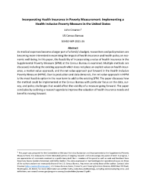Incorporating Health Insurance in Poverty Measurement: Implementing HIPM in the United States
Incorporating Health Insurance in Poverty Measurement: Implementing a Health Inclusive Poverty Measure in the United States
As medical expenses become a larger part of a family’s budget, researchers and policymakers are becoming more interested in examining the impact of health insurance and health policy on economic well-being. In this paper, the feasibility of incorporating a value of health insurance in the Supplemental Poverty Measure (SPM) at the Census Bureau is examined. Multiple methods are discussed, including the existing approach which does not place an explicit value on health insurance, a market value approach, and the net value approach put forward in the Health Inclusive Poverty Measure (HIPM). Due to production and data demands, the net value approach in HIPM is the most feasible option in the near term to add to the existing SPM. The paper discusses how the method could be implemented at the Census Bureau with particular focus on the data, survey, and policy challenges that would affect the viability of a measure going forward. The paper concludes by outlining a research agenda to improve the valuation of health insurance needs and benefits moving forward.
Others in Series
Working Paper
Working Paper
Working Paper




